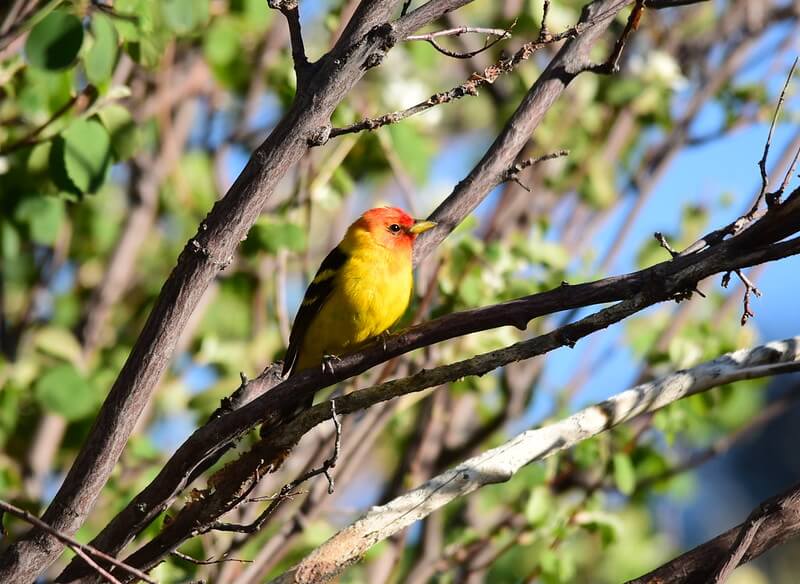Mid-May Morning Bustle on Grant Creek
by Cynthia Swidler
Broadcast 5.4 & 5.7.2021

A Western Tanager, one of the many species that depends on riparian habitat for survival. Photo by Tom Koerner/U.S. Fish and Wildlife Service (public domain image).
Listen:
It is dawn on this mid-May morning. An American Robin is singing its exuberant declaration of the day while accompanied by raindrop percussion. The morning light quickens despite the soggy gray day. Noticing where I am and the opportunity the mid-spring season presents, I soon observe energetic songbirds flitting and interspersing among the trees and shrubs along Grant Creek in north Missoula. Nature writer and educator Jon Young describes this type of bird activity as the dawn chorus followed by the morning bustle. I have observed this burst of activity to vary with season, temperature, weather conditions, number of seasonal migrant and resident birds, and breeding behaviors. On this cool, wet, spring morning, I take delight in seeing some of my favorite spring arrivals. The brightly-hued grosbeaks, Western Tanagers, and Bullock’s Orioles, with their yellow, orange, and red plumage, brighten the gray morning.
For several mornings, migrating White-crowned Sparrows have instigated the morning bustle. They have been trilling their buzzy songs over and over, sometimes serving as my alarm clock. This morning, they shine like lightbulbs in the creekside dogwoods, with their distinctively black-and-white striped heads. These are Gambel’s White-crowned Sparrows with their pale lores, the area between the eye and the beak. They will stay to rest and feed a few more days, then continue their northward migration to their nesting grounds in the taiga and tundra of the northernmost reaches of North America.
This little stretch of Grant Creek is a riparian zone near the Clark Fork River. Riparian zones are found along the banks of a river, stream, or other moving water source, surrounded by vegetation that relies on water. These habitats are home to a wide range of flora and fauna that meet birds’ survival needs. Successful bird migration and nesting depends on habitat that provides food, water, shelter, song posts, perching locations and nest sites. Riparian zones provide all of these features and support some of the most abundant and diverse bird communities in the West.
Wood’s rose, snowberry, dogwood and willow line the banks of Grant Creek. While birds utilize all of these plants, I have observed that they most frequent the tall willows here throughout each season. In Yellowstone National Park, scientists have recorded 35 songbird species in willows, noting that species diversity was higher in taller and wider willows, versus those that were over-browsed. American Goldfinches especially linger in these willows throughout the year. In winter, they are barely perceptible perched among the frosty branches in their drab olive-gold plumage. Today, the jaunty males are obvious in their striking brilliant yellow and shiny black. It is fascinating to observe American Goldfinches in their stages of molt throughout the seasons. They are the only finches that molt all of their body feathers twice per year, in late winter and again in late summer. The brightening yellow of the males each spring forecasts the promise of warmer months ahead.
On this mid-May morning, I am reminded of a quote from the writer Lynn Thomson, “I think the most important quality in a bird watcher is a willingness to stand quietly and see what comes. Our everyday lives obscure a truth about existence, that at the heart of everything there lies a stillness and a light.” Remarkably, by this morning’s end I have observed twenty-four species of birds from my window. Time has escaped me while watching the plethora of creekside birds. While the morning bustle wanes, the raspy songs of the Red-winged Blackbirds persist in the distant marsh. On a gray day, this riparian habitat with its vibrant birds allows me to rejoice in its radiance.
Every week since 1991, Field Notes has inquired about Montana’s natural history. Field Notes are written by naturalists, students, and listeners about the puzzle-tree bark, eagle talons, woolly aphids, and giant puffballs of Western, Central and Southwestern Montana and aired weekly on Montana Public Radio.
Click here to read and listen to more Field Notes. Field Notes is available as a podcast! Subscribe on iTunes, Google Play, or wherever you listen to podcasts.
Interested in writing a Field Note? Contact Allison De Jong, Field Notes editor, at adejong [at] montananaturalist [dot] org or 406.327.0405.
Want to learn more about our programs as well as fun natural history facts and seasonal phenology? Sign up for our e-newsletter! You can also become a member and get discounts on our programs as well as free reciprocal admission to 300+ science centers in North America!












